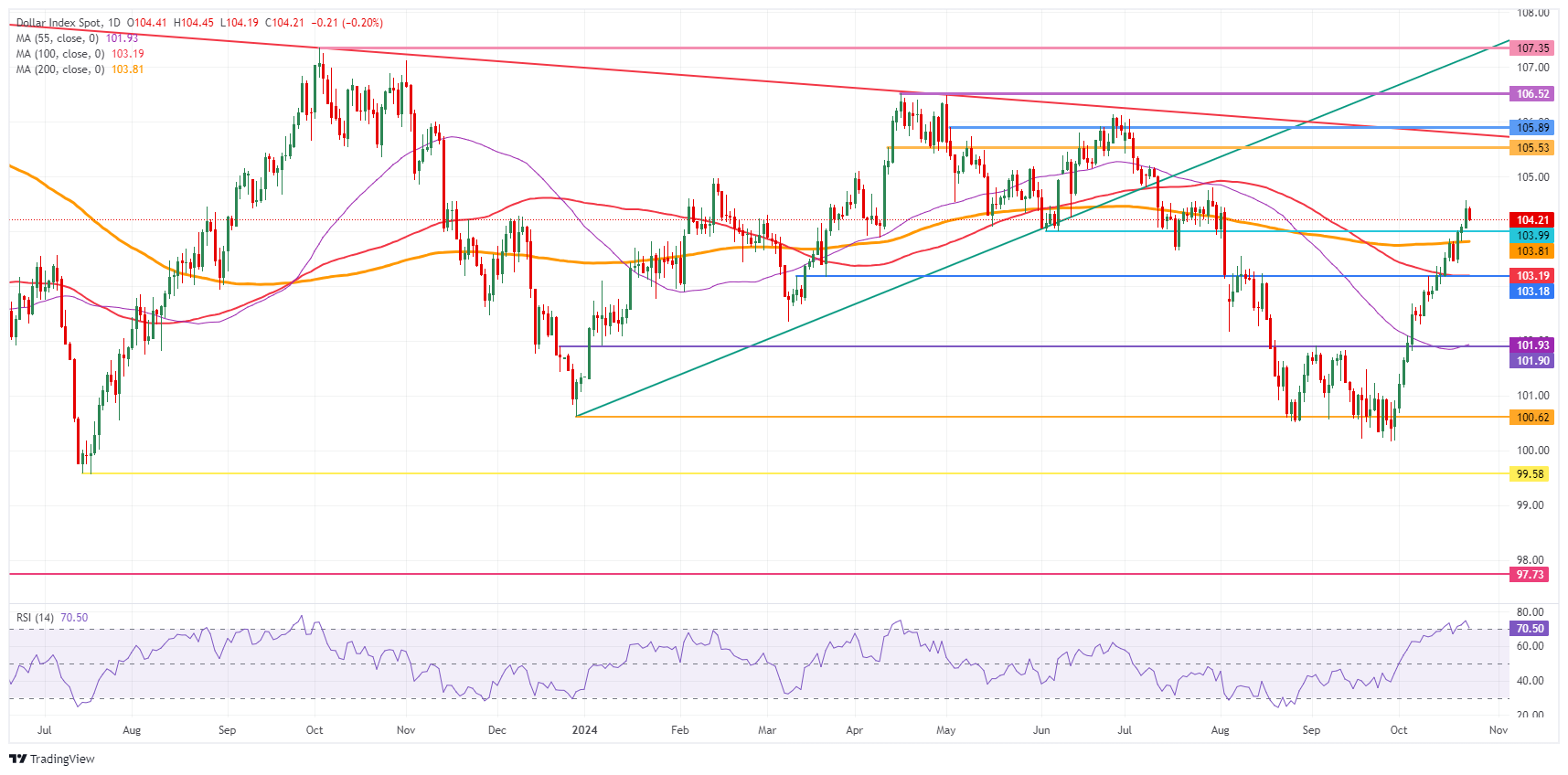US Dollar rally eases slightly as markets assess Fed policy outlook
- The US Dollar eases slightly after German PMIs came in stronger than expected.
- The risk-off tone for this week, which has been supporting the Greenback, is taking a step back.
- The US Dollar index edges down in search of support after touching an almost three-month high on Wednesday.
The US Dollar (USD) weakens slightly on Thursday ahead of a more busy day in terms of US data releases, with the Purchasing Managers Indices (PMI) data for October as the main event. Earlier on Thursday, the European PMIs came in mixed, with France contracting further in all sectors and Germany posting better-than-expected readings. Still, except for the German Services PMI, all readings for both countries – which are the Eurozone’s largest economies –remain in contraction territory.
The US calendar will also offer the PMI data, which will give insight about the state of the economy. Apart from these, the weekly Jobless Claims figures and both the Chicago Fed and Kansas City Fed activity trackers will create some additional volatility.
Daily digest market movers: Bulk load of data
- Thursday’s calendar kicks off at 12:30 GMT with the Chicago Fed National Activity Index and the weekly Jobless Claims numbers. Initial claims are expected to tick up to 242,000 from 241,000 last week.
- At 13:45 GMT, S&P Global will release its preliminary readings for the October PMIs:
- The Services PMI is expected to remain broadly stable at 55.0 from 55.2 in September.
- The Manufacturing PMI should pick up, though remain in contraction at 47.5 against 47.3 previously.
- The Composite reading stood at 54.0 in September, no forecast is available for October.
- At 15:00 GMT, the Kansas Fed Manufacturing Activity tracker for October will come in. There is no consensus view available, and the previous reading was at -18.
- The equities world turns upside down on Thursday, with China being the laggard for the first time this week while European and US equities are finally posting some gains.
- The CME Fedwatch Tool is backing a 25 basis point (bps) rate cut with an 93.0% probability against an 7.0% chance of no rate cut for the upcoming Fed meeting on November 7.
- The US 10-year benchmark rate trades at 4.19% and is trading off its high from 4.24% seen Wednesday.
US Dollar Index Technical Analysis: Not a straight line
The US Dollar rally, measured by the US Dollar Index (DXY), is taking a breather. Like with everything in financial markets, there is never a straight line for multiple trading sessions in a row, and a breather to cool down the rally a bit is more than welcome. Do not be surprised to see a bit of a turnaround as markets are still very much positioned for more US Dollar strength ahead of the upcoming US elections on November 5.
The DXY has broken above 104.00 and is in an empty area that could quickly see 105.00 emerge as the first cap on the upside. Once above that level, watch out for the pivotal 105.53 (April 11th high) and 105.89 (May 2nd high). Ultimately, 106.52 (double top April) or even 107.35 (October 3rd, 2023 high) could show sharp resistance and selling pressure with profit taking on the rally to materialize at these levels.
On the downside, the 200-day SMA at 103.81 emerges as very strong support. Look out for false breaks, and consider waiting for a daily close below that level when reassessing if there will be more downside for the DXY. The next big support is double, with the 100-day SMA at 103.19 and the pivotal 103.18 level (March 12 high). If that level breaks, a big gap lower would occur to the 101.90 support zone, with the 55-day SMA at 101.93.

US Dollar Index: Daily Chart
US Dollar FAQs
The US Dollar (USD) is the official currency of the United States of America, and the ‘de facto’ currency of a significant number of other countries where it is found in circulation alongside local notes. It is the most heavily traded currency in the world, accounting for over 88% of all global foreign exchange turnover, or an average of $6.6 trillion in transactions per day, according to data from 2022. Following the second world war, the USD took over from the British Pound as the world’s reserve currency. For most of its history, the US Dollar was backed by Gold, until the Bretton Woods Agreement in 1971 when the Gold Standard went away.
The most important single factor impacting on the value of the US Dollar is monetary policy, which is shaped by the Federal Reserve (Fed). The Fed has two mandates: to achieve price stability (control inflation) and foster full employment. Its primary tool to achieve these two goals is by adjusting interest rates. When prices are rising too quickly and inflation is above the Fed’s 2% target, the Fed will raise rates, which helps the USD value. When inflation falls below 2% or the Unemployment Rate is too high, the Fed may lower interest rates, which weighs on the Greenback.
In extreme situations, the Federal Reserve can also print more Dollars and enact quantitative easing (QE). QE is the process by which the Fed substantially increases the flow of credit in a stuck financial system. It is a non-standard policy measure used when credit has dried up because banks will not lend to each other (out of the fear of counterparty default). It is a last resort when simply lowering interest rates is unlikely to achieve the necessary result. It was the Fed’s weapon of choice to combat the credit crunch that occurred during the Great Financial Crisis in 2008. It involves the Fed printing more Dollars and using them to buy US government bonds predominantly from financial institutions. QE usually leads to a weaker US Dollar.
Quantitative tightening (QT) is the reverse process whereby the Federal Reserve stops buying bonds from financial institutions and does not reinvest the principal from the bonds it holds maturing in new purchases. It is usually positive for the US Dollar.

